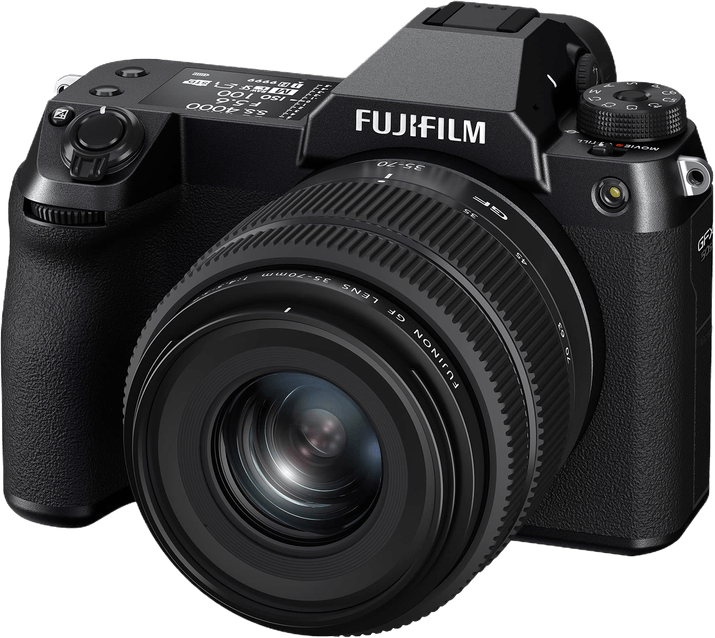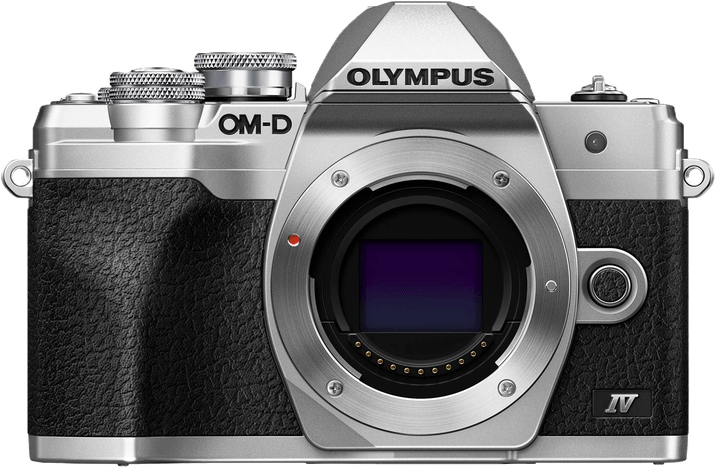Fujifilm GFX 50S II vs Olympus OM-D E-M10 Mark IV Comparison
Fujifilm GFX 50S II

Olympus OM-D E-M10 Mark IV

The Fujifilm GFX 50S II outperforms the Olympus OM-D E-M10 Mark IV with a score of 79/100 compared to 63/100. Both cameras are mirrorless and were released in 2021 and 2020, respectively. Common specifications include the launch prices of $3999 for the Fujifilm and $699 for the Olympus.
The Fujifilm GFX 50S II excels with its larger size (150 x 104 x 87mm) and heavier weight (900g), which can contribute to better stability and handling. On the other hand, the Olympus OM-D E-M10 Mark IV has a smaller size (122 x 84 x 49mm) and lighter weight (383g), making it more portable and convenient for travel.
Considering the specifications, the Fujifilm GFX 50S II offers better performance and handling, while the Olympus OM-D E-M10 Mark IV provides a more compact and travel-friendly option.
Fujifilm GFX 50S II vs Olympus OM-D E-M10 Mark IV Overview and Optics
The Fujifilm GFX 50S II outperforms the Olympus OM-D E-M10 Mark IV in optics with a score of 77/100, a difference of 14 points compared to the Olympus’ 63/100. Both cameras share some specifications, such as having a CMOS sensor, an image stabilization system, and a lens mount, allowing for interchangeable lenses. However, there are distinct differences that contribute to the Fujifilm’s superior optics.
The Fujifilm GFX 50S II boasts a medium-format sensor, which provides higher image quality and better dynamic range compared to the Olympus’ smaller Micro Four Thirds sensor. Additionally, the Fujifilm has 51 megapixels, significantly more than the Olympus’ 20 megapixels, resulting in higher resolution images with greater detail. The Fujifilm G lens mount also offers access to a range of high-quality lenses designed specifically for medium-format cameras.
On the other hand, the Olympus OM-D E-M10 Mark IV has a faster shooting speed of 15 frames per second, compared to the Fujifilm’s 3 frames per second. This makes the Olympus more suited for capturing fast-moving subjects and action photography. The Olympus also has a DXOMARK sensor score of 73, though it is important to note that Fujifilm cameras are not scored by DXOMARK.
The Fujifilm GFX 50S II excels in image quality, resolution, and dynamic range due to its medium-format sensor and higher megapixel count. The Olympus OM-D E-M10 Mark IV has an advantage in shooting speed, but overall, the Fujifilm GFX 50S II is the superior choice for those prioritizing optics and image quality.
Fujifilm GFX 50S II vs Olympus OM-D E-M10 Mark IV Video Performance
The Olympus OM-D E-M10 Mark IV outperforms the Fujifilm GFX 50S II in video capabilities with a video score of 83/100, a significant 26-point lead over the Fujifilm GFX 50S II’s score of 57/100. Both cameras share some similarities, such as having built-in time-lapse functionality. However, the differences in their video performance are more pronounced.
The Olympus OM-D E-M10 Mark IV boasts superior video resolution and frame rate. It captures 4K videos at a resolution of 3840 x 2160, while the Fujifilm GFX 50S II only manages Full HD at 1920 x 1080. Additionally, the Olympus camera can record at a maximum frame rate of 60fps, double the 30fps offered by the Fujifilm model. These advantages result in higher-quality videos with increased detail and smoother motion.
Despite its lower score, the Fujifilm GFX 50S II still has some merits. Its Full HD video resolution is suitable for casual users or those who prioritize still photography over video. Moreover, its lower video frame rate may be adequate for certain applications, and its built-in time-lapse functionality matches that of the Olympus model.
Taking these factors into account, the Olympus OM-D E-M10 Mark IV is the clear winner in video performance. Its 4K resolution and 60fps frame rate provide superior video quality, while the Fujifilm GFX 50S II remains a viable option for those who require less demanding video capabilities. Ultimately, the choice between the two cameras depends on the user’s priorities and intended applications.
Fujifilm GFX 50S II vs Olympus OM-D E-M10 Mark IV Features and Benefits
The Fujifilm GFX 50S II outperforms the Olympus OM-D E-M10 Mark IV in features with a score of 87/100 compared to 70/100. Both cameras share similarities, such as having a touchscreen, flip screen, WIFI, Bluetooth, and no GPS. However, the Fujifilm GFX 50S II excels in certain aspects, making it the superior choice in terms of features.
The Fujifilm GFX 50S II has a larger screen size of 3.2 inches, compared to the Olympus OM-D E-M10 Mark IV’s 3-inch screen. Additionally, the screen resolution of the Fujifilm GFX 50S II is significantly higher at 2,360,000 dots, as opposed to the Olympus OM-D E-M10 Mark IV’s 1,040,000 dots. This results in a clearer and more detailed display, providing a better user experience.
Despite its lower feature score, the Olympus OM-D E-M10 Mark IV still has some advantages. Its smaller size and lighter weight make it more portable and convenient for travel or daily use. However, these benefits do not outweigh the superior features of the Fujifilm GFX 50S II.
Taking into account the differences in feature scores and specifications, the Fujifilm GFX 50S II is the better camera. Its larger screen size and higher screen resolution provide a superior user experience, while the shared features of both cameras ensure a strong foundation in functionality. Although the Olympus OM-D E-M10 Mark IV has its merits, the Fujifilm GFX 50S II stands as the clear winner in terms of features.
Fujifilm GFX 50S II vs Olympus OM-D E-M10 Mark IV Storage and Battery
The Fujifilm GFX 50S II outperforms the Olympus OM-D E-M10 Mark IV in storage and battery, scoring 71/100 compared to the Olympus’ 35/100. Both cameras accept SD, SDHC, and SDXC (UHS-II compatible) memory cards and offer USB charging. However, the Fujifilm GFX 50S II boasts two memory card slots, doubling the storage capacity compared to the Olympus’ single slot.
Additionally, the Fujifilm GFX 50S II has a longer battery life, providing 440 shots with its NP-W235 battery, while the Olympus OM-D E-M10 Mark IV offers 360 shots using its BLS-50 battery. This difference gives the Fujifilm camera an advantage in extended shooting sessions.
Although the Olympus OM-D E-M10 Mark IV falls short in these aspects, it still maintains a respectable battery life and storage capacity for casual photographers. The USB charging feature is a convenient commonality between both cameras.
Considering the storage and battery capabilities, the Fujifilm GFX 50S II is the superior option with its dual memory card slots and longer battery life. The Olympus OM-D E-M10 Mark IV remains a decent choice for less demanding photography needs.
Fujifilm GFX 50S II vs Olympus OM-D E-M10 Mark IV – Our Verdict
Are you still undecided about which camera is right for you? Have a look at these popular comparisons that feature the Fujifilm GFX 50S II or the Olympus OM-D E-M10 Mark IV:

